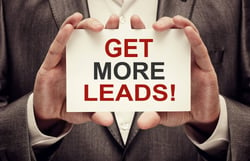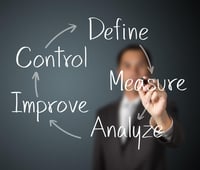Tl;dr - Lead scoring is a functionality that's often overlooked in capital equipment sales. It has applicability throughout the customer lifecycle and has the potential to improve buyer experience, increase marketing effectiveness and drive sales efficiency. Lead scoring models can start with simple inbound lead prioritization and grow increasingly sophisticated and complex.
What is Lead Scoring for B2B Industrial Sales?
 Lead scoring is the process that appends a dynamic numerical value to marketing and sales leads. The inputs, weightings and formulas vary by company, but generally include behavioral/activity factors as well as firmographic, demographic and psychographic factors. These scores are used to trigger automation that manages marketing and sales activities.
Lead scoring is the process that appends a dynamic numerical value to marketing and sales leads. The inputs, weightings and formulas vary by company, but generally include behavioral/activity factors as well as firmographic, demographic and psychographic factors. These scores are used to trigger automation that manages marketing and sales activities.
Lead scoring is an important function in optimizing sales and marketing efficiency. It's often controlled by marketing automation which in turn triggers sales force automation and CRM activities, as well as paid ad campaigns, email marketing and other functions.
While it's called "lead scoring" it might better be called contact scoring. Most scoring is managed at the contact level although it often considers company-level factors including the number of active contacts from an account.
Why is B2B Lead Scoring Important for Industrial Sales?
 Today's "leads" are often different than the leads around which marketing and sales processes have been built. A traditional lead might be a project engineer who visits a trade show booth to discuss a planned project, meets with the sales engineer who will manage the opportunity, and shares specific project details.
Today's "leads" are often different than the leads around which marketing and sales processes have been built. A traditional lead might be a project engineer who visits a trade show booth to discuss a planned project, meets with the sales engineer who will manage the opportunity, and shares specific project details.
In contrast, a contemporary "lead" is often someone from a company who reads a couple of blog articles about how to solve common industry problems and then completes a form to download a guide that offers a deeper dive into diagnosing and solving related problems.
In the first case, many of the traditional "qualification" criteria are inherently satisfied, but in the latter, there's nothing approximating a "project" with a budget, timeline, and identified decision-makers.
What should that latter contact be called? Are they a lead? Should they be contacted? By sales? Should any resources be invested in increasing awareness among their colleagues or helping them to better diagnose root causes of their problem and quantify the cost of action vs. inaction?
All of those are important questions, and as digital marketing and internet research increase, the number of "leads" like that increases in parallel, driving the need for marketing and sales teams to collaborate to create a lexicon for lead definition and classification.
Expanding buying teams (often >10 buyers), long and convoluted buying journeys, and lots of early-stage research challenge easy lead classification and assignment.
Further, industrial sales models are increasingly stratified. Marketing and sales teams have the ability to nurture early-stage leads, BDRs (business development reps) and SDRs (sales development reps) handle certain functions, inside sales others and AEs (account executives) yet others.
It's unrealistic to simply hand every "lead" from marketing to sales. Lead scoring provides the capability to gauge where each "lead" is in their journey and estimate the right type of follow up which will optimize their buyer experience and enhance the company's likelihood of close. This improves the effectiveness and efficiency of marketing and sales by relieving them of having to manually track numerous factors and simply be prompted when action is required.
Basics of Lead Scoring for B2B Teams
 First, let's acknowledge that lead scoring is inherently inaccurate. There are embedded assumptions with which we might quibble. Yet that's no different than if each member of your team looked at all the factors and tried to reach their own informed conclusion.
First, let's acknowledge that lead scoring is inherently inaccurate. There are embedded assumptions with which we might quibble. Yet that's no different than if each member of your team looked at all the factors and tried to reach their own informed conclusion.
They'd disagree. So the fact that automated lead scoring hinges on some assumptions doesn't diminish its value. And scoring is a progressive process along which you'll need to experiment and adjust the factors, weightings and formulas that you use.
What are the components of typical B2B lead scoring? Typically it includes the following:
Contact level intent factors:
- web page visits (aggregate number, specific high-value pages, frequency of return, inferred or stated stage in buying journey)
- form fills
- social media engagements
- email opens & clicks
- possible third-party contact level intent data signals (IntentData.io articles on Predictive Lead Scoring & Propensity to Buy and Lead Fit & Intent)
Contact level demographics:
- job title
- inferred (or stated) role on a buying team
- length of time with company
- previous activity
Account level intent factors:
- number of contacts from the same company taking action
- inferred (or stated) role on a buying team
Firmographics
- fit to ICP (ideal customer profile) that is aggregated into an account score - including factors specific to each business but possibly including revenue, number of locations, number of employees, growth rate, ownership (public/private investor/private family or individual), industry, profitability, philosophy, geography
- # of times quoted in the past with no results (or previous opportunities lost to competitors and lost to "no decision.")
- relationship with competitors
- key leadership/management changes (e.g. new engineering management)
- inferred (or stated) role on a buying team
Normally these factors are observed on some sort of rolling timeline (e.g. within the last 90 days) to account for velocity and decay. And a strong technology stack facilitates the enrichment of data in marketing automation and CRM by automatically pulling in details from outside sales leads databases as part of a full sales and marketing data stack.
Examples of How to Use Lead Scoring Models
 Creating a score is a first step - and one that will undoubtedly evolve. But what should you do with scores? How can you use them to improve lead generation?
Creating a score is a first step - and one that will undoubtedly evolve. But what should you do with scores? How can you use them to improve lead generation?
As you gain familiarity and expertise, you'll certainly expand on this list, but here are a few progressively complex use cases to consider.
Assign and Follow up on "Leads"
Inbound leads may not be sales-ready according to the definitions you'll create. But that can change quickly. Lead scoring can help to properly assign leads - based on industry, account, territory, etc., as well as contextual inferences.
A low-level lead from a priority target account might get sent directly to a field salesperson and simultaneously trigger account-level paid ads from marketing. On the other hand, a strong buying signal from a contact at an account that you've repeatedly quoted and never sold might just receive an automated email reply that requires "homework" from them to help justify your team's engagement in the project.
And a large number of "IQL" (information-qualified inbound leads) can be quickly titrated by observing other scoring factors to help route them to marketing, BDRs, inside sales, or field sales.
And the routing/rerouting can be quick and dynamic. For instance, a seemingly unqualified lead received on a Friday and routed to a BDR could take additional action over the weekend that results in an automated email with a meeting scheduling link and rerouting to a sales rep for immediate priority action on Monday morning.
Infer and Understand How to Optimize the Buyer Experience
When buyers hesitate to engage with sales and conduct extensive research online, many of the direct behavioral signals that traditionally guided sales discussions are hidden. Scoring models can be used to aggregate and interpret signals that can be used to automatically trigger or prompt certain actions.
These could include dynamically displaying variable website content that's tailored to a buyer's persona (either inferred - such as through the content with which they've engaged, or explicit - e.g. through a job title field on a form). It might mean adjusting chatbots from engagements offering additional top-of-the-funnel content to more direct engagement and meeting scheduling. Or assigning outreach from a technical salesperson early in the process to satisfy a prospect's strong need for technical details and as a segue for a salesperson focused on the business case.
These are simple examples. The point is that the types of observations you'll aggregate can be used to guide activity beyond simply adjusting a score.
Provide Dynamic Sales Coaching
A huge, and often missed opportunity of marketing automation is to provide contextual advice and coaching to sales. Often there's extensive information available in contact records in marketing automation and CRM that might not get full attention from the sales team as they plan and prioritize follow-up and engagement.
For example, a prospect might submit an RFQ from a page focused on a semi-automatic machine solution. That would normally trigger a straightforward discussion and quote.
But what if they had spent as much or even more time on a related page - for the automatic version of the machine? That would indicate that they are at least interested in a higher-level solution, but then opted for the lower level in their inquiry. Of course, we can only surmise why. Perhaps they're concerned about cost, implementation, operator skill levels, or lead-time, or any of many other factors.
But there's a great potential up-sell opportunity if the salesperson understands the context and the questions to ask.
So why not provide that information with the lead alert to the rep? Marketing can create automation, based on the same observations that inform B2B lead scoring, that can highlight the recent activity and note reasonable inferences. For instance:
"This contact submitted the semi-auto RFQ but also visited the auto page 7 times. They are probably unsure which is the best solution. So during your outreach, you should consider:
- sharing this guide (linked) which explores the pros/cons of auto and semi-auto solutions
- ask the following questions
- "Experience tells me that many companies are worried about labor and talent challenges and are trying to automate more. Are those discussions you're having internally?"
- "Sometimes companies assume that automation won't be justifiable. How does your team weigh investment vs. return?"
- "Often companies have had frustrating experiences with levels of automation that were oversold. Are there any organizational biases around more or less automation?"
- enroll the prospect in the "ABC" sales sequence which is designed for inbound leads who have requested a quote and are considering a range of solutions"
Remember, the point of your lead scoring system is to improve the effectiveness and efficiency of your marketing and sales activities. The more you can know what buyers are thinking, and use that to shape their experience appropriately, the more effective your team will be. Further, by pushing dots close together for your sales team - either directly or through automated coaching - you'll make them more efficient.
The Full Lead Scoring Journey
When you understand how scores are constructed and the ways in which they accelerate decisions and actions, you'll start to see other applications.
Company scoring was mentioned above. Not only can that be used to gauge fit against the ICP, but an account level score can also be used to:
- automatically add a domain to paid ad campaigns
- trigger a workflow to add a company to a target accounts and/or ABM (account-based marketing) list
- create segmented targets lists for certain "competitive knock-out" campaigns or M&A triggered activity
- scoring plant locations/child accounts distinctly from HQ/parent accounts
The dynamic nature of "lead scoring" models can also be applied elsewhere, like in opportunity scoring. This is supposed to happen to some degree by advancing through progressive stages in a pipeline. But how often does the pipeline really take into account important factors that reflect on the likelihood of close? For instance, if there's no engagement within three days of sending a proposal? Or if through team selling you have contact with 80% of the buying team members? Or if a prospect visits your facility for lab testing with your team?
Those are just examples of signals which could be used to decrease or increase an opportunity score. The score in turn could trigger automation to move a deal back in the pipeline and/or reduce the forecast likelihood of close. It could also be used as a prerequisite for advancing to a later stage.
And why not customer scoring? It's common in the capital equipment world that some customers drift toward 3rd party aftermarket vendors. But engaging with your knowledge base or downloading a manual could boost their "customer score" and trigger outreach and/or special offers from the success team.
B2B Lead Scoring, Automation & Creativity
 Marketing automation and CRM should be much more than repositories for contact details. The volume of leads, contacts, and companies that sales reps need to track, engage with, and manage is growing. So their efficiency and effectiveness must too.
Marketing automation and CRM should be much more than repositories for contact details. The volume of leads, contacts, and companies that sales reps need to track, engage with, and manage is growing. So their efficiency and effectiveness must too.
The nature of leads and buying journeys makes outcomes far more chaotic and far less predictable today than in the past. It's critical to deliver the right information to the right people at the right stage in their buying journey. The sales enablement function is charged with creating that information, and lead scoring for B2B industrial sales teams can facilitate the complex analytical and task management challenges of delivering it effectively.
Lead scoring is a journey. Companies can start with a simple lead scoring model to prioritize inbound leads and then gradually refine and expand their scoring models with the ultimate goal of dynamic propensity-to-buy modeling and predictive lead scoring.
The key is to start - based on collaborative efforts of manufacturing marketing and industrial sales teams.


